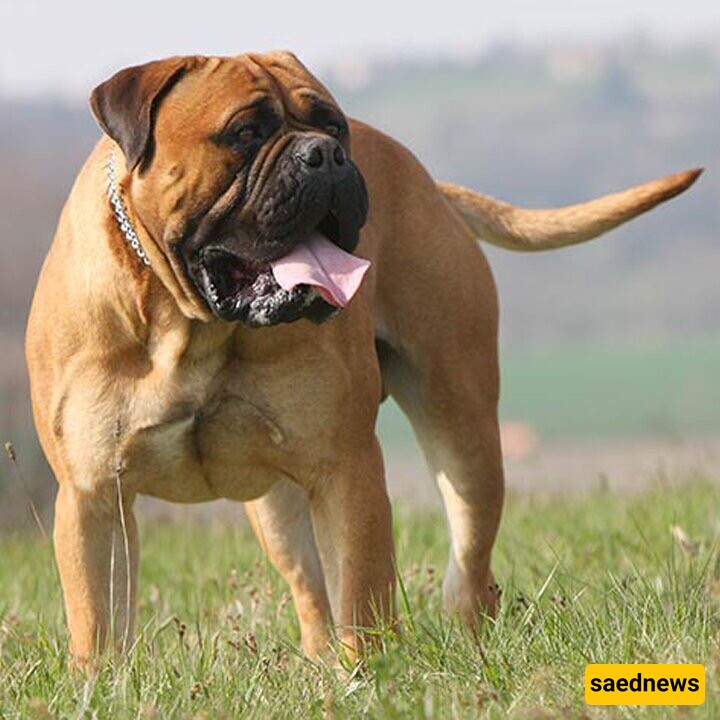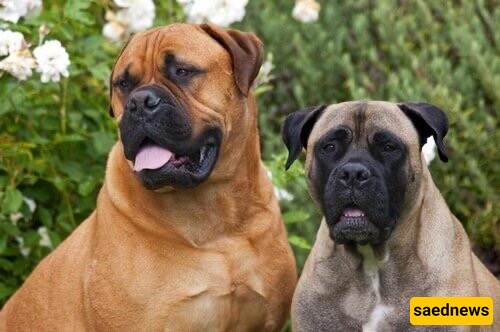The Bullmastiff is an incredibly lovable dog with an adorable face, ranking among the best breeds for companionship in the United States. Stay with us until the end of this article from Saed News to learn more about this fascinating breed.

Known as "The Gamekeeper’s Night Dog," this nickname perfectly summarizes the breed’s origins. From the mid to late 19th century, vast estates in the countryside were frequently targeted by poachers. A breed historian once wrote, "Punishments were severe, but eradicating poaching through laws alone seemed impossible. Since poachers, if caught, could face the death penalty, they had nothing to lose when confronted by a gamekeeper. In a desperate situation, they might choose to shoot the gamekeeper rather than risk the gallows."
To counter this, gamekeepers began breeding dogs that were large, fast, agile, and courageous enough to chase and capture trespassers. Eventually, they found the perfect combination: 60% Mastiff and 40% Bulldog. This new breed was intelligent enough to follow commands, tame enough to be controlled, and intimidating enough to deter intruders.
Over time, competition arose among English gamekeepers over who had the best-quality Bullmastiffs. Shows and exhibitions were held to display the finest specimens. As Bullmastiff enthusiasts worked to standardize the breed, dog shows gained popularity in England. By 1924, Bullmastiffs were officially recognized by the Kennel Club in England, and in 1933, the American Kennel Club (AKC) followed suit.

The Bullmastiff is an imposing dog, exuding power, endurance, resilience, and high alertness. This muscular and active breed was developed in England by gamekeepers to protect against poachers. It is a crossbreed of 60% Mastiff and 40% Bulldog.
Male Bullmastiffs typically stand between 63 to 70 cm (24-27 inches) tall, while females range from 60 to 66 cm (23-26 inches). Males weigh between 50 to 60 kg (110-132 lbs), and females weigh between 45 to 55 kg (99-121 lbs). Their lifespan is approximately 7 to 9 years.
Bullmastiffs are known for their affectionate nature and unwavering loyalty. They will protect their owners at all costs, earning a reputation as selfless guardians. They are highly alert and make excellent watchdogs. However, unless provoked or angered, they are obedient and well-mannered.
This breed is fearless and courageous, always ready to stand its ground when encountering anything suspicious. In normal situations, Bullmastiffs are calm and quiet, displaying ideal behavior. They are not naturally aggressive but will attack immediately if they perceive a threat. Due to their strength and determination, they require a strong, independent owner who can establish leadership.
Bullmastiffs require daily walks to maintain their physical health and satisfy their instinct to roam. Dogs that do not receive adequate exercise may develop behavioral issues. Keep in mind that in a Bullmastiff’s mind, the leader must always walk ahead—it should be the human, not the dog. Similarly, when entering a doorway, the owner should always go first.
It is recommended to feed a Bullmastiff 3 1/8 to 4 1/8 cups of high-quality dog food daily, divided into two meals. The amount of food a dog needs depends on its age, body structure, metabolism, and activity level. Like humans, dogs have individual dietary needs, and their food quality varies.
Instead of leaving a full bowl of food available throughout the day, provide nutritious meals in measured portions. To prevent obesity, feed your dog twice a day and monitor portion sizes. If you're unsure whether your dog is overweight, conduct a simple check:
Look at your dog from above—you should be able to see a waistline.
Place your hands on its back, thumbs along the spine, and fingers on the sides. You should be able to feel the ribs without pressing too hard. If you cannot feel the ribs, your dog may be overweight and should receive less food and more exercise.
Bullmastiffs can adapt well to apartment living as long as they receive regular exercise. They are very calm indoors, making them suitable for home life. A small yard or balcony is sufficient for their daily movement. However, they cannot tolerate extreme heat.
Since Bullmastiffs have an instinct to migrate, they require daily walks to fulfill this need. Owners must establish leadership by always walking ahead of their dog and entering doorways first.
Bullmastiffs shed seasonally, which is expected. However, excessive hair loss should be considered a potential health issue. A balanced diet and a clean environment are crucial for maintaining coat health. Regular grooming helps manage shedding and ensures their skin and coat remain in good condition. Any unusual dryness or oiliness could indicate dietary issues or allergies.
Early training and socialization are crucial for Bullmastiff puppies. This breed can be strong-willed, so structured training from an early age benefits both the dog and the owner. Establishing rules and routines early on ensures they are followed as the dog grows.
Many breeders recommend enrolling new owners and their puppies in local obedience classes. This provides exposure to other dogs and allows owners to learn proper training techniques. Bullmastiffs excel in agility, obedience, tracking, and scent-related tasks, making early training an essential part of their lifelong bond with their owner.
Bullmastiffs are patient with children and make excellent protectors. However, due to their large size, they may accidentally step on or knock over small children. If you have young kids, consider getting a smaller or younger Bullmastiff.
Supervision is necessary when Bullmastiffs interact with children to prevent accidental harm. Teach children not to disturb the dog during training or mealtime. Even the most well-behaved dog should be leashed when around small kids.
Bullmastiffs are generally not aggressive, but if not properly socialized, they may become dominant or aggressive toward smaller dogs. However, with the right training, they can coexist peacefully with cats and other pets.
Common health concerns in Bullmastiffs include:
Hip dysplasia
Cancer
Tumors
Eyelid problems
Lip fold dermatitis
To prevent obesity, divide their meals into 2-3 smaller portions instead of one large meal per day. This breed has a tendency to gain weight if overfed.
Bullmastiffs are incredibly loyal and protective, willing to put their lives on the line for their owners. They are affectionate, alert, fearless, and courageous, making them excellent guard dogs. They are strong, agile, and large enough to deter intruders. Although obedient and well-behaved under normal circumstances, they will attack immediately if they sense a threat. They generally get along well with children and other dogs when properly trained.
If you're looking for a devoted companion and a fearless guardian, the Bullmastiff might be the perfect breed for you.

